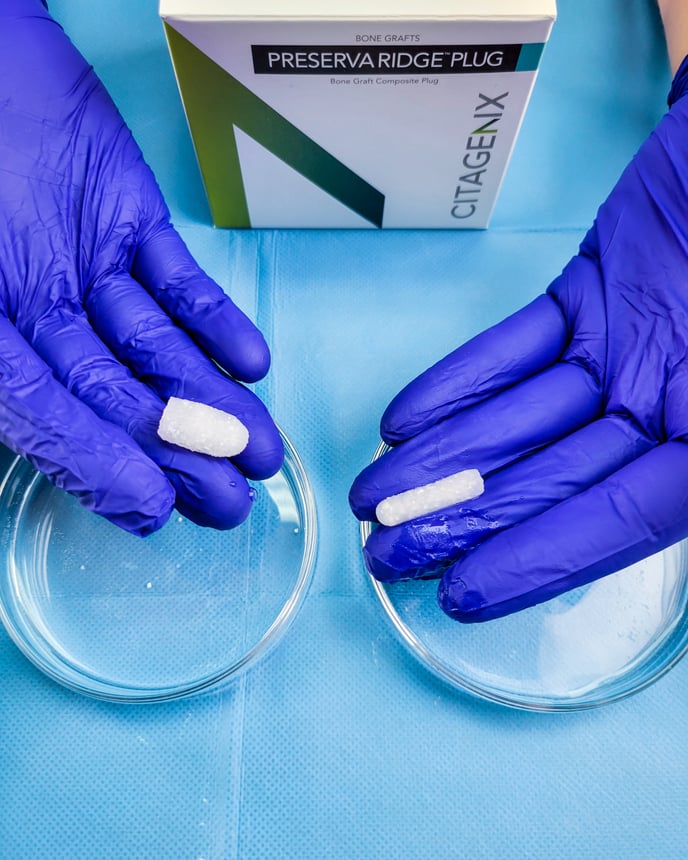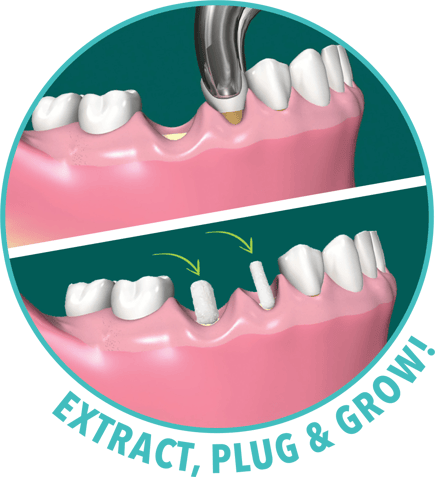Bone Grafts
Choose from the industry’s most complete range of dental bone grafts! Our product line includes bone substitutes based on human bone (allograft)...
Product characteristics
No, Raptos is available in vials, wide-mouth round bottom jars and syringes.
Raptos is available in cortical, cortico-cancellous blend, cancellous, demineralised and Premium Blend ( 70% mineralised cortical and 30% de-mineralised cortical.).
It is available in vials for the following: Cortical, Cortical-Cancellous, Cancellous, Demineralised Cortical and the Premium Blend.
It is available in jars (where you can actually mix and hydrate the product) in: Cortical, Cortical-Cancellous and Cancellous.
It is available in syringes in Cortical, Cortical-Cancellous, Cancellous, Demineralised Cortical and Premium Blend.
Please refer to the Product page for information on particle sizes.
Composition of our ridge / socket preservation bone graft plug.
PreservaRidge™ Plug material source: Synthetic Carbonate Apatite & Bovine Type I Collagen
PreservaRidge™ Plug is a synthetic plug that mimics natural bone and is made of approximately 80% mineral particles combined with 20% Type I collagen from bovine Achilles tendon. It is specifically designed for use in post extraction treatment to help maintain ridge height and width.
Definition of carbonate-apatite:
apatite containing a considerable amount of carbonate, such as:
a: apatite in which the calcium phosphate carbonate predominates over other components
b: calcium phosphate carbonate

Composition of PentOS OI™ Flex.
PentOS OI™ Flex is made of demineralized, osteoinductive 100% cortical bone.
The five elements of bone formation with PentOS OI™ Flex.
Post sterilization in-vivo testing is performed on each batch, and each batch must demonstrate the presence of new bone, bone marrow, osteocytes, cartilage and chondrocytes within 28 days in an athymic rat model. If not, they do not call it PentOS OI™.
What type of bone is used to manufacture PentOS OI™ Max?
PentOS OI™ Max is made from 100% human allograft demineralized bone matrix and is cortical bone.
Applications
Types of bone grafts used in dehiscence or volume maintaining cases.
Most bone grafts are indicated for bony defects but their individual characteristic offer advantages in certain surgical cases. Based on this the clinician is best suited to chose the appropriate graft. You may want to use a putty (C-Blast Putty™) to help keep the graft material contained. If the issue is addressing the dehiscence, and if the patient is healthy and blood supply is not an issue, an allograft, such as Raptos®, is predictable and most commonly used. If maintaining volume is the priority, a xenograft such as THE Graft™ is a great option. It remodels as fast as an allograft and maintains great volume.
Option for patients who do not want an allograft or xenograft.
Citagenix has an extensive product offering and we therefore have an option for your patient. You can offer Eclipse™, a 100% synthetic bone substitute that completely transforms to natural bone. It is made of hydroxyapatite (HA) and tricalcium phosphate (TCP) (20% HA, 80% TCP).
Xenograft refers to a tissue graft or organ transplant from a donor of a different species from the recipient.
Allograft refers to the transplant of an organ or tissue from one individual to another of the same species with a different genotype. For example, a transplant from one person to another, but not an identical twin, is an allograft.
Different options for when a case requires a longer remodel time.
Eclipse™ would be a good choice as it is good for ridge preservation and takes approximatively 9 to 18 months to completely remodel into new bone. Studies have shown that the regenerated volume of bone is maintained as long as five years.
Product comparisons
Raptos® allograft irradiated bone particulates offers a natural scaffold for bone regeneration.
The Cortico-cancellous Raptos® bone comes from sections of the illium which are ground into several particulate sizes.
The blend of cortical and cancellous that results from this process gives this product the structure of cortical, with the open scaffolding for bone to grow into offered by cancellous.
The Raptos® Premium Blend is Cortical Mineralized/Demineralized blend combines two of the most popular allograft particles used in dentistry, all in a single vial.
Comparison of porcine versus bovine bone substitute.
THE Graft™ has shown better bone quality early on in bone formation. It has also shown a better inflammatory response than the bovine counterpart. Comparison of porcine vs bovine bone substitute for alveolar socket preservation.
Characteristics that make THE Graft™ a standout product in the xenograft market.
THE Graft™ has been shown to have higher porosity and permeability than other xenografts. THE Graft™ consists of a unique inter-connection pore system that ensures an efficient fluid intake and allows the migration of cells. The pore system and high surface energy enhances the osteoconduction process.
Product combinations
Adding to your grafting material to bulk up your graft.
Sometimes you will have cases that require more volume than you have available to you. One solution would be to add Eclipse™ as well as a demineralized allograft mixture at the site to maximize regeneration and long-term retention.
Raptos® as a standalone product, but also used as a graft extender.
Yes, Raptos® can be mixed with different grafts, such as C-Blast Putty™, if you are looking to augment the graft or to help contain the grafts on site. It also can be mixed with antibiotics if needed.
If primary closure is not possible, the use of a membrane is highly recommended.
Normally, a dental membrane is used to prevent the epithelial cells from growing into the bone graft site, where new bone is forming.
A Neomem® membrane also helps to keep the granules at the graft sight, preventing migration of the granules. A membrane is also used when primary closure is not possible. However, if the periosteum is still intact, it can be used to achieve primary closure.
If the periosteum is damaged in any way, a membrane, such as Neomem® or Neomem® Flexplus, should be used.
Can different products be mixed with allograft products?
C-Graft Putty™ and C-Blast Putty™ are versatile grafting solutions and allow dental surgeons to incorporate other bone types. An autogenous bone, a xenograft or particulate bone can be added to the C-Blast Putty™ or C-Graft Putty™, which allows the granules to be contained and allows for easier placement.
Safety information
Composition of PentOS OI™ that is 100% derived from human bone.
Every batch used to manufacture PentOS OI™ products is verified to be osteoinductive and histologically demonstrates all five elements of bone formation.
- New bone
New bone is the final step in the maturation of the product. - Bone marrow
The presence of bone marrow indicates the ability of the product to differentiate into osteoblasts, chondrocytes, cartilage and new bone. - Osteocytes
Osteocytes are derived from osteoblasts, or bone forming cells, and are essentially osteoblasts surrounded by the products they secreted. - Cartilage
Cartilage is replaced by bone during ossification in the higher vertebrates. It is indicative that the bone formation is forthcoming. - Chondrocyte
A Chondrocyte is a unique cell type in articular cartilage tissue and is essential for cartilage formation and functionality. It arises from mesenchymal stem cells.
Osteoconduction provides the guidance, osteoinduction encourages the transformation of undifferentiated cells to active bone cells and osteogenesis, living osteoblasts within the graft material aid in the bone renovation process.
See our Successful Bone Graft article.
History of each donor and sterilization protocol.
Each donor used to produce Raptos® is thoroughly evaluated using medical/social history questions, medical records, blood tests, culture results, physical examination and autopsy reports (when performed). This process is used to ensure the donor is suitable for donation by allowing to recognize and exclude potential diseases or medical conditions that are unacceptable.
Specific lab tests are performed for Syphilis, Hepatitis B and C, HIV and other viruses.
All of the donor chart information is evaluated by individuals trained in tissue banking prior to processing the tissue. Tissue grafts are rinsed and soaked in various solutions to minimize transmission of bacteria and viruses.
Processing and packaging of the tissue are performed using an aseptic technique and occur in a clean room. As an added margin of safety, a low dose gamma irradiation after final packaging of the musculoskeletal grafts is utilized.
Safety and efficacy of THE Graft™.
THE Graft™ quality and safety have been scientifically demonstrated with in vitro and in vivo studies, large case study reports and randomized clinical trials.
Acquisition of bone to produce the Raptos® bone particulate.
For the manufacture of Raptos®, only donors that meet or exceed FDA & AATB eligibility requirements are accepted.
All donors are recovered within the United States, over 6,000 donors recovered in 2016.
Features & Benefits
The benefits of using allograft vs autograft.
An autograft can result in harvest site patient morbidity and complications, so it is sometimes best to use an allograft such as Raptos®, C-Blast Putty™, C-Graft Putty™ or PentOS OI™ Putty. If you have a patient who will have trouble healing, or one that does not want to deal with secondary site discomfort, an allograft is a good option.
The advantages of using putties in your surgical procedures.
Putties help keep granules on site when there is no proper pocket to contain them.
The carrier allows the putty to be molded and transformed, giving surgeons the ability to manipulate the putty to the shape they want.
The versatility of C-Blast Putty™, C-Graft Putty™ or PentOS OI™ Putty allows them to be used in different surgical procedures.
Many advantages of using the PentOS OI™ Max
- Mixed PentOS OI™ Max can be extruded through a syringe.
- It resists copious irrigation and has a five-year shelf life at ambient storage.
- Shown to form bone post-sterilization in-vivo.
- Demonstrates osteoconductivity.
- It can be used in patients with compromised immune systems, older patients and those who have more difficulty growing new bone.
The features of PentOS OI™
There are many benefits to using PentOS OI™ Putty:
- Verified to be osteoinductive
- Osteoconductive
- Excellent handling characteristics
- Resists irrigation
- Sterilized using low-dose gamma irradiation
- Ready to use
- Stored at room temperature
General definitions
Three key elements of bone regeneration
![]()
| Scaffolds Allograft chips or synthetic granules provide the osteoconductive elements to encourage the attachment of osteogenic precursor cells. Scaffold maintains volume of the defect site while anchoring surrounding cells. | |
| Signals Proven osteoinductive properties of BMPs in demineralized bone stimulates the growth of new bone. | |
| Cells Patient’s own osteoblasts, osteoclasts and mesenchymal stem cells integrate with the graft material. |
Osteoconduction provides the guidance, osteoinduction encourages he transformation of undifferentiated cells to active bone cells and osteogenesis, living osteoblasts within the graft material aid in the bone renovation process.
Variety of bone grafts available
Xenograft refers to a tissue graft or organ transplant from a donor of a different species from the recipient, such as THE Graft™, one of our complete range of dental bone grafts.
The Graft™ is a Xenograft that is structurally similar to human tissue. It has a high level of porosity combined with natural interconnectivity. It is designed to mimic the structure of human bone, offering osteoconductive properties to host cell growth and complete remodeling to host bone.
Summary of an allograft putty and its use.
Allograft bone putties are processed human bone that has been demineralized and an added carrier.
The carrier is usually proprietary to each manufacturer; it can come in many different forms such as RPM, CMC or glycerol.
Sometimes it is 100% derived from bone like PentOS OI™ Putty . Versatile and economical allograft putties would be C-Blast Putty™ and C-Graft Putty™ as they can be used in many situations and have a carrier (CMC) to help keep granules onsite.



